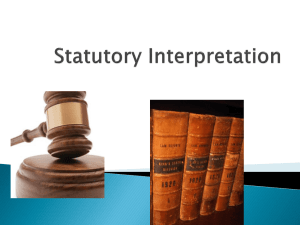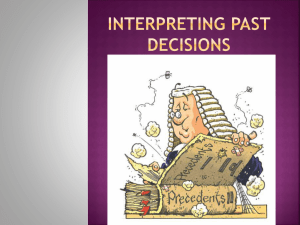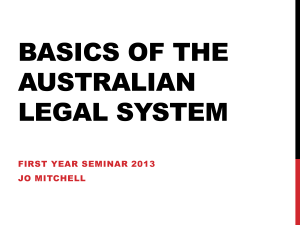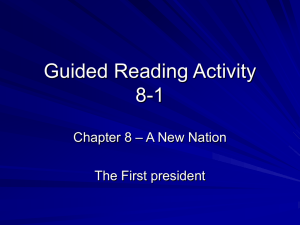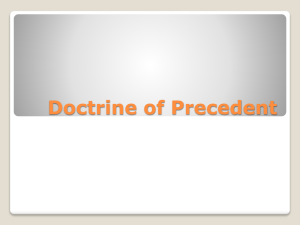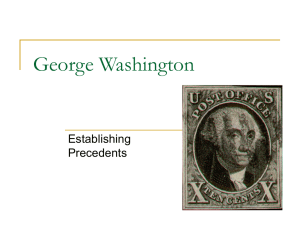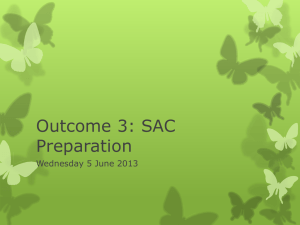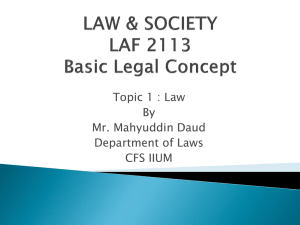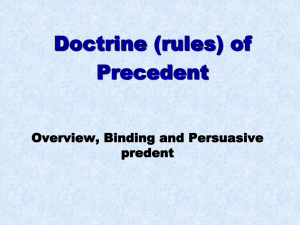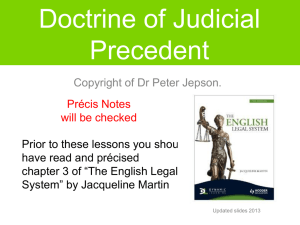PRACTICE SAC 3 mark sheet
advertisement
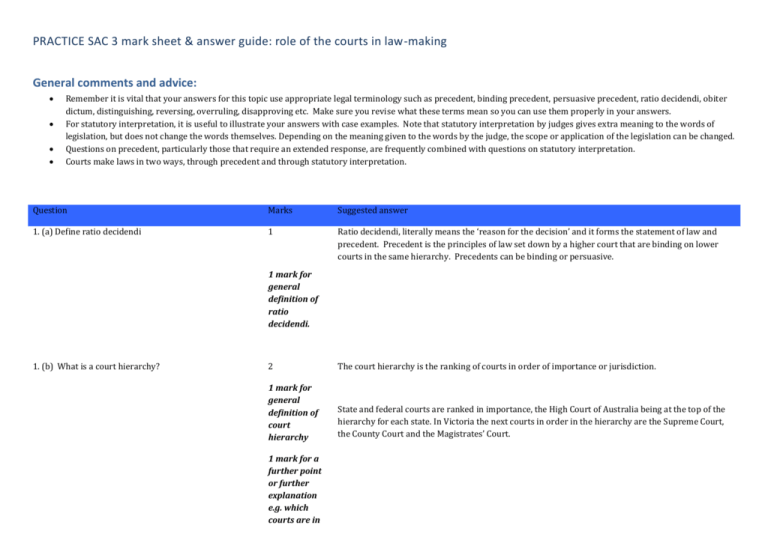
PRACTICE SAC 3 mark sheet & answer guide: role of the courts in law-making General comments and advice: Remember it is vital that your answers for this topic use appropriate legal terminology such as precedent, binding precedent, persuasive precedent, ratio decidendi, obiter dictum, distinguishing, reversing, overruling, disapproving etc. Make sure you revise what these terms mean so you can use them properly in your answers. For statutory interpretation, it is useful to illustrate your answers with case examples. Note that statutory interpretation by judges gives extra meaning to the words of legislation, but does not change the words themselves. Depending on the meaning given to the words by the judge, the scope or application of the legislation can be changed. Questions on precedent, particularly those that require an extended response, are frequently combined with questions on statutory interpretation. Courts make laws in two ways, through precedent and through statutory interpretation. Question Marks Suggested answer 1. (a) Define ratio decidendi 1 Ratio decidendi, literally means the ‘reason for the decision’ and it forms the statement of law and precedent. Precedent is the principles of law set down by a higher court that are binding on lower courts in the same hierarchy. Precedents can be binding or persuasive. 1 mark for general definition of ratio decidendi. 1. (b) What is a court hierarchy? 2 The court hierarchy is the ranking of courts in order of importance or jurisdiction. 1 mark for general definition of court hierarchy State and federal courts are ranked in importance, the High Court of Australia being at the top of the hierarchy for each state. In Victoria the next courts in order in the hierarchy are the Supreme Court, the County Court and the Magistrates’ Court. 1 mark for a further point or further explanation e.g. which courts are in the Victorian court hierarchy 2. Distinguish between binding precedent and persuasive precedent and explain when these apply. 3+3=6 2 marks – explanation of binding precedent; 1 mark – example of when a precedent is binding Binding precedent: the precedent (reason for the decision, or ratio decidendi) is binding on future cases in the same hierarchy, provided the material facts are the same. For a precedent to be binding on a particular case, the precedent must be: • from the same hierarchy of courts • from a superior court — one that is higher in the hierarchy. [Note: The High Court is not bound by its own previous decisions. However, in the interests of consistency, it will usually follow its previous decisions, unless it believes that a previous decision is not good law, or a previous precedent is outdated because of changes in attitudes, technologies or other circumstances.] 2 marks – explanation of persuasive precedent; 1 mark – example of when a precedent is persuasive Persuasive precedent: decisions from other hierarchies or from a court lower in the same hierarchy can act as persuasive precedent. This is influential on other courts, but not binding. Precedents considered to be persuasive but not binding are: • from courts in another hierarchy, such as other states or countries • from courts on the same level of the hierarchy (which are not binding) • from inferior courts (that is, courts lower in the court hierarchy) • obiter dicta contained in a judgment of a court in the same hierarchy or in another hierarchy. 3. Describe the operation of the doctrine of precedent. Does the operation of the doctrine of precedent enable 6 1 mark for Precedent is the reasoning behind a court decision that establishes a principle or rule of law that must be followed by other courts lower in the court hierarchy when deciding future cases that are similar. courts to make laws? defining precedent. 1 mark for identifying ratio decidendi; 1 mark for identifying obiter dictum; 2 marks for full explanation of how precedent enables courts make laws. There are two parts of a decision that are important for precedent: the ratio decidendi and the obiter dictum. ratio decidendi is the legal reasoning for the decision that forms the legal principle or binding precedent. obiter dictum comments are those parts of a judge’s decision that do not form the legal reasoning for the decision but are “said by the way”. These comments may form persuasive precedent. Precedent enables courts to make law as the courts decide on a new issue that is brought before them or when a previous principle of law requires expansion to apply to a new situation. An example of the courts ability to make a law was the case of Grant v. Australian Knitting Mills (1936) AC 85. The court referred back to the case of Donoghue v. Stevenson. Although this case was a persuasive precedent as it was in another court hierarchy, the court chose to follow the decision in the case. The court found that the injured party was successful in suing Australian Knitting Mills for negligence and the law of negligence was clearly established in Australia. This is one case in which precedent was used to create a new law. 1 mark for example 4. With the use of illustrative examples, explain the process used by the courts to develop common law through the doctrine of precedent. Include two ways in which judges can avoid following precedent created in previous cases. [Note: For full marks, it is expected you need to have a detailed explanation of precedent using the relevant terminology, how precedent comes about, how judges can follow/avoid precedents, and case examples for developing an area of law.] 12 Answers should include the following: The quality of discussion would determine the marks award, but most of the listed points would need to be included. an explanation of the doctrine of precedent – this should be a detailed explanation that includes the distinction between binding and persuasive precedent, and the concepts of stare decisis, ratio decidendi and obiter dictum that precedent comes about through: o the process of judges adjudicating disputes, and needing to determine issues of law that relate to the case before them; o where there may currently be no law (either statue or common law) which is appropriate for the particular dispute before the court the need to follow previous decisions of courts – whether binding or persuasive precedent when precedent occurs ways in which judges may be able to avoid precedent if they think it is not appropriate for their case – reversing, overruling, distinguishing, and disapproving, and in the process developing precedent [To copy test 5 q5] illustrative examples could include the development of the law of negligence culminating in Donoghue v Stevenson and Grant v Australian Knitting Mills. 5. ‘Parliament’s task is to legislate, but the impact of that legislation can be affected by how it is interpreted by the courts’. (a) (b) Identify and explain one reason why courts sometimes have to interpret a statute. For this reason, include one example to support your answer. Describe two effects of statutory interpretation. 6 1 mark for identifying and explaining the reason 1 mark for example. 4 marks for explanation of the effects of statutory interpretation (2 marks for each effect). Any two of the following: Mistakes occur during the drafting of an act. The meaning of the words can change over time. The act might not have taken into account future circumstances. The intention of the action might not be clearly expressed. There might be inconsistent use of the same word. An act may not include new types of technology. Parliamentary counsel, when drafting legislation, may not have used correct technical terms. There may be inconsistencies with other statutes. The act may be silent on an issue and the courts may need to fill gaps in the legislation. The meaning of the words may be ambiguous. Most legislation is drafted in general terms. Effects of statutory interpretation: (any two of the following): * Acts of Parliament are applied to the cases that come before the courts. * The words in the act are given meaning. * Precedents are set for future cases to follow * The parties to the case are bound by the decision * Consistency and predictability in the law * Courts can override or reverse a previous decision of courts *Parliament can abrogate law made by courts *Restricting the law though narrow interpretation of the statute *Extending the law through broad interpretation of the statute. Whenever a judge engages in statutory interpretation, precedent is created. This precedent is binding on lower courts in the hierarchy. The words within the statute, plus their interpretation, are read together to form the law. Words and phrases within the legislation are given meaning by the courts. A wide interpretation of a word or phrase in the statute could result in the law being extended to cover new situations (e.g. Brislan’s Case). Conversely, a narrow interpretation of a word or phrase in the statute may narrow the scope of the law. For example, in Deing v. Tarola, a studded belt was said to be a weapon only if it was being used as such. 6. Evaluate two strengths of courts as a law making body. 4 At least two of the following effects for 2 marks, plus detailed explanation (eg example) for further 2 marks. Strengths of law-making through courts Courts act independently. Because judges are appointed, not elected, they are not subjected to the same level of political scrutiny. Because they do not need to be re-elected, their decisions can reflect the law rather than the populist view. Courts apply legislation to day-to-day cases. Judges rule on cases before them. This makes their decisions relevant to today's circumstances. Interpretation of words in statutes allows for common, modern-day usage of words to be considered and applied. Courts can act quickly. As courts are not burdened by the strict parliamentary processes involved in passing a Bill (the various reading stages and debates in both houses of parliament), courts can quickly change the law through their decisions in the cases before them. Courts can fully consider all arguments. Precedents are the result of court cases, where the adversary system allows all arguments and evidence to be examined and cross-examined. This helps to ensure judges are fully informed when arriving at a decision. Courts can develop areas of law. As society changes, courts can develop areas of law to keep pace with society's views and values. The development of the law of negligence, liability for the safe-keeping of animals and native title are examples where courts have developed an area of law. Courts provide consistency and fairness. Precedents allow for the law to be applied consistently where the material facts of a case are similar. This provides certainty and helps to ensure that all people are treated equally and fairly before the law. Courts can provide flexibility. By allowing judges to distinguish, overrule and reverse precedents, courts have a degree of flexibility in the manner in which they apply the law and create new laws. In evaluating a strength, you need to consider corresponding weaknesses. Judges are not elected. When parliament creates a law it is using the authority given to it by the electorate. Judges are not elected and, therefore, groups affected by court-made law have no recourse to democratic processes to challenge the decision. Courts can only act on cases before them. Courts must wait for a case to come before them. People must have ‘standing’ to be involved in a court case and must be able to afford to take their case to the higher courts in order for a court to create a precedent. In this sense, the courts’ ability to make law that is far-reaching is limited because they must confine themselves to the case at hand. 7. Discuss two reasons why precedent may or may not provide for effective law-making, and explain the reason why it is a strength or weakness. 6 4 marks – identifying two advantages or disadvantages of precedent 2 mark – detailed discussion of reasons why Courts cannot seek public input. Parliament can use law reform bodies to investigate areas of law requiring change. Courts are unable to seek public views and input when deliberating on a case. In this sense, law-making through the courts is limited because judges are not privy to extensive consultation that often takes place before parliament enacts law. Courts can be slow to make law. Courts are not able to act independently and must wait for a case to come before them. This can lead to the law changing slowly through the courts. E.g. development of the law of negligence. Courts act retrospectively. Judges make laws when settling disputes in cases before them. As the act (or omission) has already occurred, the law is, therefore, made ex post facto — after the fact. Courts can be inflexible. Judges are not elected and law-making is not their primary role. These factors can see them reluctant to distinguish or overrule precedents and create new laws. See the runaway car case study below. Any two of the following reasons: Advantages and disadvantages of precedent Argument Precedent provides consistency and fairness Precedent provides certainty Precedent provides flexibility Precedent provides for growth in the law Advantage The doctrine of precedent provides for consistency and fairness in the resolution of disputes because parties can feel confident that cases with similar facts will be treated like those in the past. Disadvantage Outcomes may not always be consistent. One case may appear similar to earlier cases, but the processes of overruling, reversing, disapproving and distinguishing may result in a very different decision. Parties may feel that they can predict the An outcome is difficult to predict outcome of their case based on the because sometimes there is more than decisions of previous similar cases. one precedent that may apply to the case before the court. Precedent can be flexible because it can be Judges are conservative by nature and changed by a superior court when a case of may prefer to follow earlier decisions similar facts is distinguished from an rather than make a new precedent, thus earlier one. the law remains inflexible on a particular issue. Areas of law may develop and grow over Growth in the law through the courts is the years as similar cases are heard slow and expensive. The courts must allowing judges to elaborate and expand wait for cases to come before them, precedents in a particular area of law. and, consequently, parties must be prepared to take their dispute to court. Precedent is efficient The doctrine of precedent provides principles of law for judges to follow. Judges are independent and impartial and can make decisions without fear of political interference. Precedent may be regarded as inefficient because it relies on a dispute occurring and the parties being prepared to take their case to court. Then it can be a very lengthy and expensive process. Question Marks Suggested answer 8. To what extent do parliaments and courts act as a partnership in law making? Justify your view. 8 4 marks – discussing the four ways that courts and parliaments interact. ; parliaments make laws to establish courts. Courts apply and interpret the law made by parliament Parliament can change or confirm law made by the courts Court decisions can prompt a change in the law made by parliament. 1 mark for the full explanation of each of these methods. 2 marks – discussing example of the interaction between courts and parliament in law making (Mabo v. Queensland (1992). 1 mark – indicating extent of agreement Total /50
